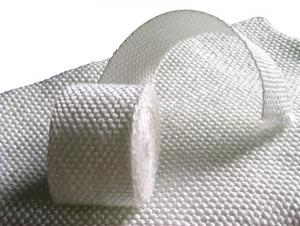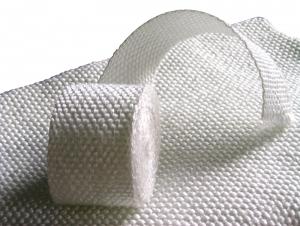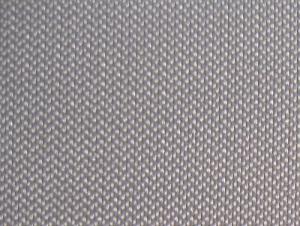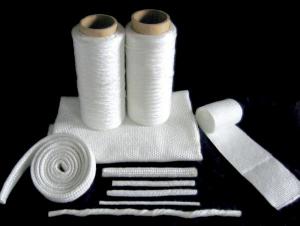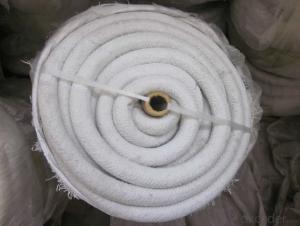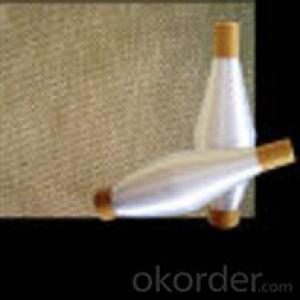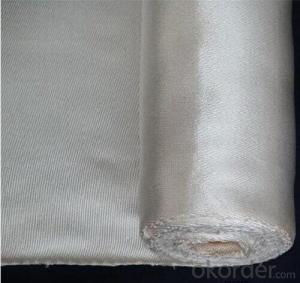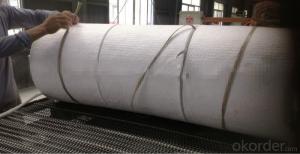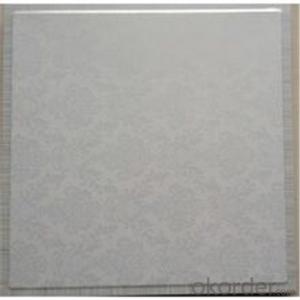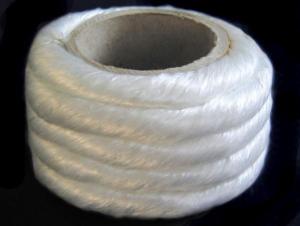Textured Fiberglass Adhesive Tape
- Loading Port:
- China Main Port
- Payment Terms:
- TT or L/C
- Min Order Qty:
- 5t kg
- Supply Capability:
- 2*/20FCL Per Month kg/month
OKorder Service Pledge
OKorder Financial Service
You Might Also Like
Basic info of Textured Fiberglass Adhesive Tape It is fabricated from high quality texturized C glass or Eglass fiber yarns that will not burn and will withstand continuous exposure to temperatures of 1022F/550C.
2. It resists most acids and alkalis and is unaffected by most bleaches and solvents.
3. It is an excellent substitute for asbestos tape.
4. Texturized fiberglass tape with copper wire, nickel wire or stainless wire are also available.
Applications of Textured Fiberglass Adhesive Tape:
1. All types of thermal insulation and heat protection provide of industrial wires, cables, hoses, tube and pipe and also provide thermal insulation and personnel protection.
2. Used as a gasket or seal.
Features of Textured Fiberglass Adhesive Tape
Good alkali resistance
High tensile strength and resistance to deformation
Excellent self-adhesiveness
Good smoothness
Convenient application in construction
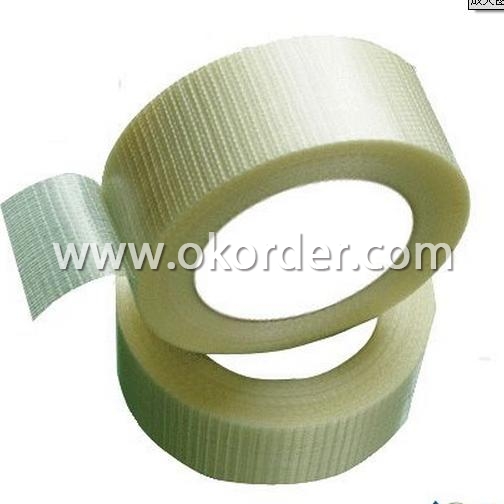

- Q:What are the advantages of using glass fiber textile in composites?
- There are several advantages of using glass fiber textile in composites: 1. High strength: Glass fibers are known for their exceptional strength-to-weight ratio. When used as a reinforcement in composites, they provide high tensile strength and stiffness, making them suitable for applications that require strength and durability. 2. Lightweight: Glass fiber textiles are lightweight, which helps in reducing the overall weight of the composite material. This is particularly advantageous in industries such as aerospace and automotive, where weight reduction is critical for fuel efficiency and performance. 3. Corrosion resistance: Glass fibers are highly resistant to corrosion and do not react with chemicals or moisture. This makes them suitable for applications in harsh environments, such as marine, chemical, or oil and gas industries, where corrosion resistance is essential. 4. Electrical insulation: Glass fibers have excellent electrical insulation properties, making them ideal for applications where electrical conductivity needs to be minimized. This is particularly important in industries like electronics and telecommunications. 5. Chemical resistance: Glass fibers are resistant to most chemicals, acids, and alkalis. This makes them suitable for applications where exposure to harsh chemicals or corrosive substances is expected. 6. Design flexibility: Glass fiber textiles can be easily molded into complex shapes, allowing for the creation of intricate designs and structures. This flexibility in design offers greater freedom to engineers and designers when developing composite components. 7. Cost-effective: Glass fiber textiles are relatively inexpensive compared to other reinforcement materials such as carbon fiber. This makes them a cost-effective choice for applications where high strength and durability are required, but budget constraints exist. Overall, the advantages of using glass fiber textiles in composites include their high strength, lightweight nature, corrosion resistance, electrical insulation properties, chemical resistance, design flexibility, and cost-effectiveness. These properties make glass fiber textiles a popular choice in various industries, ranging from construction and automotive to aerospace and electronics.
- Q:Can glass fiber textiles be used in reinforcement of nanocomposites?
- Yes, glass fiber textiles can be used in the reinforcement of nanocomposites. Glass fibers provide excellent mechanical properties, such as high strength and stiffness, making them ideal for enhancing the overall strength and durability of nanocomposite materials. Additionally, glass fiber textiles can also improve the dimensional stability and impact resistance of the nanocomposites.
- Q:Can glass fiber textiles be used for bulletproof applications?
- Yes, glass fiber textiles can be used for bulletproof applications. Glass fiber textiles are known for their high tensile strength and resistance to impact, making them suitable for bulletproof vests, helmets, and other protective gear. The tightly woven structure of glass fibers can effectively dissipate and distribute the kinetic energy of a bullet, reducing the chances of penetration. However, it is important to note that glass fiber textiles alone may not provide complete protection against high-velocity bullets, and additional layers or materials may be required to enhance the bulletproof capabilities.
- Q:Are glass fiber textiles suitable for automotive interiors?
- Yes, glass fiber textiles are suitable for automotive interiors. They are known for their strength, durability, and resistance to heat, making them ideal for use in car interiors. Glass fiber textiles can be used for various purposes such as seat covers, carpeting, headliners, and door panels, providing excellent insulation and enhancing the overall aesthetics of automotive interiors.
- Q:Can glass fiber textiles be used for making geotextiles or erosion control products?
- Yes, glass fiber textiles can be used for making geotextiles or erosion control products. Glass fiber textiles are known for their high strength and durability, making them suitable for applications that require resistance to extreme weather conditions, chemical exposure, and mechanical stress. Geotextiles and erosion control products are designed to stabilize soil, prevent erosion, and reinforce structures in civil engineering and construction projects. Glass fiber geotextiles offer excellent tensile strength and dimensional stability, making them effective in preventing soil erosion and providing reinforcement to soil structures. These textiles can be used in various applications such as retaining walls, embankments, roadways, and drainage systems. Additionally, glass fiber textiles have low elongation, meaning they do not stretch or deform easily under load, ensuring long-term effectiveness. Therefore, glass fiber textiles are a viable option for making geotextiles or erosion control products due to their strength, durability, and resistance to environmental factors.
- Q:How do glass fiber textiles compare to carbon fiber textiles?
- Both glass fiber textiles and carbon fiber textiles are widely used in various industries due to their high strength and lightweight properties. However, there are several key distinctions between these two materials. To begin with, glass fiber textiles are created by weaving together fine strands of glass, resulting in a fabric. They are renowned for their exceptional thermal insulation properties and find common applications in insulation, filtration, and reinforcement in construction materials. Glass fiber textiles are generally more cost-effective in comparison to carbon fiber textiles. On the contrary, carbon fiber textiles are formed by bonding carbon atoms in a crystal alignment, resulting in an incredibly strong and lightweight material. Carbon fiber textiles possess a higher tensile strength than glass fiber textiles, making them suitable for high-performance applications such as aerospace, automotive, and sports equipment. Furthermore, they display excellent resistance to chemical corrosion and can withstand high temperatures. Another crucial distinction lies in the stiffness and flexibility of these materials. Carbon fiber textiles exhibit higher stiffness, providing greater structural integrity and rigidity. Glass fiber textiles, although still robust, are more flexible and can be molded into intricate shapes. This flexibility renders them more suitable for applications requiring bending or shaping. Regarding weight, carbon fiber textiles are significantly lighter than glass fiber textiles. This weight advantage contributes to enhanced fuel efficiency in transportation applications and enables faster and more agile sports equipment. In conclusion, while glass fiber textiles excel in thermal insulation and affordability, carbon fiber textiles offer superior strength, stiffness, and lightweight properties. The choice between these two materials depends on the specific requirements of the application, with carbon fiber textiles being preferred in industries that prioritize high-performance and lightweight characteristics.
- Q:What are the different sewing techniques for glass fiber textile?
- There are several different sewing techniques that can be used for glass fiber textiles. One common technique is the straight stitch, which is used to join two pieces of fabric together. This is done by sewing a straight line of stitches along the edge of the fabric. Another technique is the zigzag stitch, which is used to add strength and durability to a seam. This stitch creates a zigzag pattern along the edge of the fabric, providing a more secure hold. A third technique is the overlock stitch, also known as a serger stitch. This stitch is used to finish the edges of fabric, preventing fraying and providing a professional-looking finish. In addition to these basic sewing techniques, there are also specialized techniques for working with glass fiber textiles. For example, when sewing with glass fiber fabrics, it is important to use a sharp needle specifically designed for these types of fabrics. This helps to prevent the needle from breaking or becoming dull. Additionally, it is recommended to use a heavier weight thread, such as polyester or nylon, to ensure a strong and secure stitch. Overall, the specific sewing techniques used for glass fiber textiles will depend on the project and the desired outcome. However, by using these techniques and taking proper precautions, it is possible to create high-quality and durable garments or other items using glass fiber textiles.
- Q:Are glass fiber textiles biodegradable?
- Glass fiber textiles are not biodegradable, as they are made from non-biodegradable silica. Consequently, these textiles do not naturally decompose and can endure in the environment for an extended duration. Nevertheless, glass fibers have the potential to be recycled and reused, thereby lessening their environmental impact.
- Q:How durable are glass fiber textiles?
- Glass fiber textiles possess remarkable durability, owing to their composition of inherently strong and wear-resistant glass fibers. As a result, these textiles exhibit an exceptional ability to endure diverse environmental conditions and physical stresses. Moreover, glass fiber textiles demonstrate resistance to chemicals, abrasion, and UV radiation. They exhibit a notable resistance to degradation when exposed to harsh chemicals or sunlight, rendering them suitable for outdoor use. Additionally, the high melting point of glass fibers allows them to withstand high temperatures without compromising their structural integrity. Furthermore, glass fiber textiles boast outstanding tensile strength, enabling them to resist stretching and breaking under tension. This characteristic makes them well-suited for applications that prioritize strength and durability, such as reinforcing concrete in the construction industry or in the production of composite materials. In conclusion, the exceptional durability of glass fiber textiles makes them a dependable choice for numerous applications that necessitate strength, resistance to chemicals and UV radiation, and the ability to withstand diverse environmental conditions.
- Q:How do glass fiber textiles compare to synthetic fiber textiles?
- Glass fiber textiles and synthetic fiber textiles have some similarities, but also key differences. Both types of textiles are man-made materials, offering durability and strength. However, glass fiber textiles have the advantage of being highly heat-resistant, making them suitable for applications such as insulation in high-temperature environments. On the other hand, synthetic fiber textiles, such as polyester or nylon, are often more flexible, lightweight, and water-resistant, making them ideal for a wide range of uses, including clothing and outdoor gear. Ultimately, the choice between glass fiber and synthetic fiber textiles depends on the specific requirements of the intended application.
1. Manufacturer Overview |
|
|---|---|
| Location | Beijing, China |
| Year Established | 1992 |
| Annual Output Value | Above US$ 3 Million |
| Main Markets | North America;Southeast Asia ;Western Europe ;Middle East |
| Company Certifications | ISO 9001:2008 |
2. Manufacturer Certificates |
|
|---|---|
| a) Certification Name | |
| Range | |
| Reference | |
| Validity Period | |
3. Manufacturer Capability |
|
|---|---|
| a)Trade Capacity | |
| Nearest Port | Tianjing |
| Export Percentage | 60% - 70% |
| No.of Employees in Trade Department | 21-50 People |
| Language Spoken: | English; Chinese |
| b)Factory Information | |
| Factory Size: | Above 10,000 square meters |
| No. of Production Lines | Above 8 |
| Contract Manufacturing | |
| Product Price Range | High; Average |
Send your message to us
Textured Fiberglass Adhesive Tape
- Loading Port:
- China Main Port
- Payment Terms:
- TT or L/C
- Min Order Qty:
- 5t kg
- Supply Capability:
- 2*/20FCL Per Month kg/month
OKorder Service Pledge
OKorder Financial Service
Similar products
New products
Hot products
Hot Searches
Related keywords
